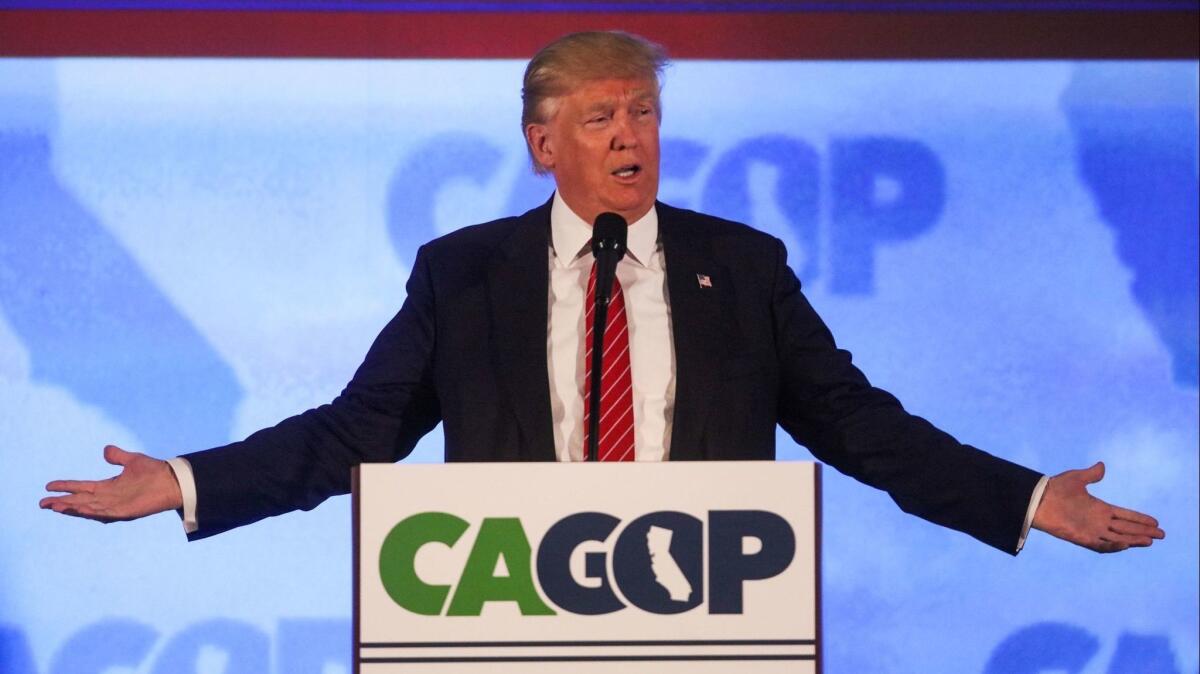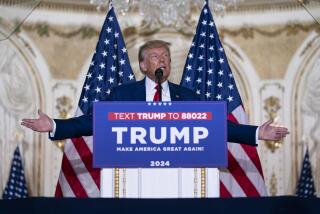Analysis: To measure the real base of California’s Republican support, look no further than Trump’s approval numbers

- Share via
Reporting from Sacramento — From all corners of the California political world — Democrats and Republicans, campaign consultants and researchers — a hearty thanks may be in order to President Trump. Just a day away from a decisive election, the polarizing chief executive has provided a simple shorthand for measuring GOP relevance in the Golden State.
To calculate the size of the Republican base, just look at the president’s job-approval number. Find that loyal Trump supporter, goes the logic, and you’re looking at a voter who will stick with Republican candidates through hell or high water.
That number, according to a recent poll, is about 39% of statewide likely voters.
The nonpartisan Public Policy Institute of California found that this core group of GOP voters is centered among the ranks of white male voters. Many live near San Diego or in the Central Valley. Most are registered Republicans, though some are unaffiliated “independent” voters. Many attended college but didn’t leave with a degree.
Given the animus of the state’s elected officials toward Trump’s policies, 39% support for the president among likely California voters is a reasonably strong showing. (And it’s worth noting that the president’s job approval is much lower among all adults — another example of how the electorate doesn’t accurately reflect the state as a whole.) It’s less uplifting, though, for a Republican who’s trying to win statewide office.
Trump may have helped reveal the contours of the party’s base, but his reputation could also create a shatterproof ceiling come election day.
John Cox, the GOP businessman gubernatorial candidate who moved to California from Illinois in 2011, is running neck and neck with Trump. PPIC’s recent survey found 38% of likely voters back Cox over Democratic Lt. Gov. Gavin Newsom, essentially tied with the president’s approval rating. Last week, two additional polls — one from UC Berkeley, another from the nonpartisan research firm Gravis — pegged Cox’s support at between 35% and 40%. Gravis found that 36% of California voters surveyed like Trump.
There’s historical precedent to the idea that the Republican base is close to 40% of voters who cast ballots. While its share of registered voters has fallen to just 24% — less than independent voters — the GOP continues to cobble together a coalition of party faithful and conservative nonconformists in numbers that can eclipse the larger liberal, but more disengaged parts of the state’s electorate.
“Even with declining Republican registration in the state, it seems to be staying at that 40%,” said Kevin Spillane, a GOP strategist.
The percentage may be the California political version of baseball’s “Mendoza line,” the boundary between a respectable and a ridiculed batting average in the major leagues, nicknamed for retired infielder Mario Mendoza. Being above it isn’t exactly a sign of success, but below it almost always means failure.
Cox’s predecessor as the state GOP gubernatorial pick, Neel Kashkari, was spot-on perfect on this count: In the 2014 election against Gov. Jerry Brown, he won 40% of the vote.
Kashkari was a newcomer to California politics who served as an assistant Treasury secretary under Presidents George W. Bush and Obama. Like Cox, he stepped forward when better known GOP politicians decided against running. After losing to Brown, he left California to become president of the Federal Reserve Bank of Minneapolis.
That 40% mark in general-election votes — let’s call it the “Kashkari line” — offers a marker by which to track statewide Republican campaigns. In races for governor since 1990, it’s a rung on the ladder that only one candidate has failed to reach: Dan Lungren, who in 1998 as California’s attorney general garnered only 38% of the vote against Democrat Gray Davis.
Gov. Arnold Schwarzenegger was the most successful, winning reelection in 2006 with 56% of the vote. Former Gov. Pete Wilson also pushed far past the line to win a second term in the GOP’s historic landslide election of 1994.
Others barely crossed the line, though, even when they had plenty of money for their effort. Meg Whitman, the billionaire candidate who spent $178.5 million, captured only 41% of the vote in 2010. Bill Simon, the GOP’s wealthy hopeful eight years earlier, maxed out at 42%.
Republicans running for statewide offices other than governor, in so-called down-ticket races, have also hovered around the line. Two GOP candidates four years ago — Ashley Swearengin for state controller and Pete Peterson for secretary of state — topped out at 46% of the vote in losing efforts that November.
But the hurdles are especially high now, at the height of the national Republican brand’s toxicity to millions of moderate California voters. Even tougher is a top-two primary system that excludes third-party and write-in candidates from the fall ballot. Twice in the last three decades, a fractured electorate allowed the winner in the governor’s race — Davis in 1998, Wilson in 1990 — to claim victory with less than 50% of the vote.
For Cox to have a chance in these final days of the 2018 election, he has to win almost all the undecided voters in recent polls while siphoning off lukewarm Newsom voters. He would also need to escape Trump’s shadow, which probably felt more like shelter when the president endorsed Cox during the primary campaign in May. Newsom is trying to make the governor’s race a referendum on Trump, with television ads that mention the commander in chief — not his Republican opponent.
And the ads highlight another problem: Cox doesn’t have the money to answer back. The state’s GOP standard-bearer is heard but not seen as the election draws near, forced by limited cash to make his closing argument only on radio. The kind of widely seen TV advertising blitz for which California campaigns are known would cost at least $3 million a week. As of late October, Cox had less than $600,000 left to spend.
Spillane, who coordinated an independent political action committee in support of Kashkari’s bid four years ago, said some traditional GOP donors have given up on races for governor. A Times analysis found fewer than six dozen donors to Kashkari’s candidate committee from 2014 who have given money to Cox’s 2018 effort.
“A number of them, frankly, think it’s just futile,” Spillane said.
Wealthy backers have instead been urged to spend their money on California’s hot congressional races in which Republicans are fighting for survival. Or they’re trying to win enough GOP seats in Sacramento to keep Democrats from a legislative supermajority.
But Tuesday’s election could face the most significant test to the size of the Republican base of any in modern history, as the electoral typhoon wrought by Trump hits just as the state continues moving to the political left. And at a time when all of the campaign metaphors are weather-related — surges, waves, floods — Cox and the other severely underfunded statewide GOP hopefuls may soon be left to board up the windows and tryto ride out the storm.
Follow @johnmyers on Twitter, sign up for our daily Essential Politics newsletter and listen to the weekly California Politics Podcast
More to Read
Get the L.A. Times Politics newsletter
Deeply reported insights into legislation, politics and policy from Sacramento, Washington and beyond. In your inbox three times per week.
You may occasionally receive promotional content from the Los Angeles Times.











